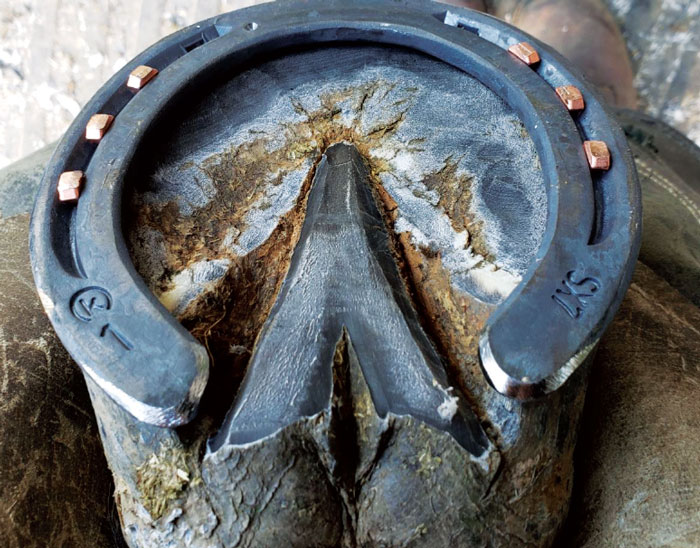Thrush is a common problem in equine hoof care. The result of less-than-ideal environmental conditions coupled with poor hoof hygiene, thrush can range in severity from causing mild discomfort during hoof picking to outright lameness.
As persistent as it can be, thrush is simple — if not easy — to treat. When applied correctly, over-the-counter topical medication will treat most cases of thrush. When good management strategies are employed, most horses will overcome thrush with no lasting effects.
What is Thrush?
According to Lydia Mudd, DVM, CF, of Janssen Veterinary Clinic in Cicero, Ind., thrush is a common hoof infection that may be caused by a variety of bacterial or fungal pathogens.
“Studies have been done where they’ve tried to culture and see if there is one specific pathogen that will grow, but it’s always a mixed population of microbes,” Mudd explains. “There’s not one bacteria or fungus we can look at and say is solely responsible for causing thrush.
Takeaways
- Thrush is an infection that thrives in areas where oxygen is not present. The equine frog is most susceptible.
- The foot must be cleaned before over-the-counter topical medications are applied. The medication should be allowed to dry before turning out the horse.
- Horse owners can help prevent thrush by cleaning the feet daily, keeping the horse out of wet surfaces until they are dry and maintaining a routine farrier schedule.
“The clinical signs and the way the infection progresses are very similar regardless of the specific bacteria or fungi,” she continues. “Essentially, it’s going to look the same no matter what pathogens are involved.”
Thrush is an anaerobic infection, meaning it thrives in areas where oxygen is not present; in horses, the frog is most susceptible.
“Usually, we’ll see it affect the medial and lateral commissures or the central sulcus, or both,” says Cody Bogard, CJF, of Cicero, Ind. “The commissures get packed with mud and manure, and that’s a prime breeding ground for thrush.”
Thrush can affect all hooves or a single hoof, depending upon environmental factors, hoof conformation and individual susceptibility.
Identifying Thrush
When it comes to identifying thrush, there are several key factors to look for, Mudd says.
“When a horse has thrush, the pathogens are eating away at the tissue that comprises the frog,” she says. “You may notice the actual size of the frog seems to shrink — this is due to the degradation or atrophy caused by thrush. It’s also common for the frog itself to look raggedy, or to have portions that are beginning to peel away.”
In addition, Mudd says it’s not uncommon to see a black, tarry discharge originating from the central sulcus or the commissures.
“That discharge is a byproduct of the microbes and the hoof degradation,” she explains. “It’s unique to thrush.”
Bogard agrees, noting that there's also a distinct, easily identifiable odor.
“Part of that tarry substance is necrotic tissue from the frog, and it has a putrid smell,” he says. “If you’re cleaning out a hoof and notice a foul odor, it’s a pretty good indication of thrush.”
Bogard says horses with thrush may also present with varying degrees of sensitivity or lameness.
“In the majority of cases, the horse isn’t going to be sore enough to be lame,” he says. “But if you go digging around with a hoof pick, you’ll get a reaction. A lot of times the horse will be sore along the commissures or within the central sulcus. In more severe cases, it can be advanced enough to cause lameness. It’s rare, but it happens.”
Treating Thrush
For both Mudd and Bogard, over-the-counter topical medications are the go-to treatment for most cases of thrush.
“There are a variety of topical treatments you can get at any local store,” Bogard says. “There are liquids, powders and aerosols. I advise my clients to go with something that can get into each of the crevices because that’s what’s going to resolve the infection.”
How the treatment is applied is as important as what you treat with, he says.
“The foot has to be clean before it’s treated,” Bogard explains. “If it’s not thoroughly cleaned, we’re just treating the dirt and debris and not getting to the foot itself.”
Mudd adds that she advises clients to allow time for the medication to dry before turning the horse out.
“If you clean a hoof and then toss the horse right back outside, very little medication is going to reach the tissue that needs to be treated,” she says. “Bring horses in, clean their feet out, apply your medication and then give the topicals some time to dry. That’s going to give you the most benefit.”
Prevention and Management
Mudd and Bogard emphasize the importance of proper environmental management when it comes to treating and preventing thrush. First and foremost, Mudd advises horses should be kept in a clean, dry environment when possible.

A routine farrier schedule helps keep hooves free from thrush. Photo by: Heath Lash
“What it comes down to is keeping feet in as dry and hygienic of an environment as possible,” Mudd explains. “When a hoof is excessively worn down or overly softened from exposure to moisture, it makes the frog vulnerable and allows bacteria or fungi to infiltrate. We don’t see thrush in arid climates because even if the microbes are there, the frog is rock hard and can’t be infiltrated.”
Areas where horses spend a lot of time tend to attract mud and manure where potentially dangerous pathogens thrive. Water troughs, hay feeders and gates are often hot spots.
“I advise putting substrate down because these areas tend to have a lot of moisture and mud,” Mudd says. “Limestone, small gravel, or sand can help.”
If an environment change isn’t possible, putting the horse in a dry stall overnight — or just a few hours — can help.
“If you have an environment you know is susceptible to thrush, try to get ahead of it,” Bogard advises. “Clean the feet out every day — at least once, no exceptions. And then either leave the horse tied or stalled to allow the clean feet some time to be exposed to the air before turning them back out. A few simple management strategies can go a long way.”
Keeping horses on a regular farrier schedule also helps prevent thrush.
“Routine farrier care allows us to make sure the hoof is being trimmed appropriately and the frog is in good health,” he explains. “It also allows us to ideally catch any cases of thrush early before too much damage is done.”
When the Worst Happens
While thrush is generally mild and easily treatable, severe cases can happen.
“In a mild case, we’re going to start with exterior portions of the frog that have been eaten away by the bacteria,” Bogard explains. “As it spreads, we may see fissures or holes in the horny frog itself. Within the commissures, we’ll likely notice sensitivity when picking feet out and in more severe cases, we may see bleeding.”
If the infection impacts the central sulcus or deeper structures within the frog, the horse may experience significant pain and lameness.
“Severe cases of thrush within the central portion of the frog can destabilize the entire hoof,” Bogard says. “It can lead to the medial and lateral sides of the heel moving independently more than they are designed to. The infection can also eat far enough into sensitive structures that we end up with an infection into the digital cushions.”
While most cases of thrush that Mudd sees remain mild, those that are left untreated can lead to complications.
“Some horses become sensitive to walking on any sort of uneven surface,” she says. “We see lameness in more severe cases and sometimes the horny tissue is so damaged that the sensitive tissue underneath is exposed. But there’s no reason for the infection to become that rampant. With good daily care and environmental management, we can stay on top of it easily.”
Owner Compliance
Since daily management plays a pivotal role in treating and preventing thrush, making sure the owner is on board with the treatment plan is vital.
For some horse owners, stalling horses to allow feet to dry or installing a substrate to improve environmental conditions may not be feasible. Bogard tries to assess expectations for each client individually to develop the best plan.
“As farriers, we need to look at the owner’s compliance as well as their ability to execute the plan,” Bogard explains. “There are a lot of owners who say, ‘Sure, I can treat that every day, no problem.’ Then they treat it once or twice and never follow through. We need to be able to assess which type of client we’re dealing with and determine how quickly we need to get ahead of things depending on the severity of the case.”
Learn More Online
Gain more insight on thrush by reading:
- "How to Identify and Treat Thrush" by Stephen O'Grady
- Watching "Treating Thrush on a Racehorse"
- "How to Prevent and Treat Thrush in Horse Hooves" by Katie Navarra
If owner compliance or ability is in question, Bogard pushes for a specialized shoeing package.
“If I have any question about the owner’s commitment to the plan, I’ll opt for pads and packing,” he says. “A lot of times if I give owners the option, it’s what they’ll decide to go with anyhow — it’s easier and takes the responsibility off of them and it’s often what’s in the best interest of the horse.”
If there’s no sensitive tissue exposed, Bogard uses copper sulfate under the packing, which will kill off any microbes.
Mudd also recommends pads and packing in instances when owner compliance is in question, but emphasizes the importance of using the correct packing material.
“My biggest concern is making sure whatever is contacting the tissues is, in and of itself, antimicrobial,” Mudd explains. “Remember, thrush likes an anaerobic environment, so if you take a thrushy frog and seal something over it in a dark, anaerobic environment, you’re going to make the thrush worse.
“We can have good outcomes preventing and treating thrush by putting a good antimicrobial packing underneath a pad and shoe because it prevents all the outside factors from influencing the tissues, which gives them the chance to regenerate and become healthy. We just have to be sure we’re using the right tools.”









Post a comment
Report Abusive Comment